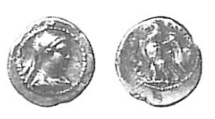S 639 - Uncertain mint, silver, diobol?, 185-170 BC
From SILVER
185 - 170 Silver 0 kg
Description
| ObverseInscription or printing placed on the obverse.: | Bust of Dionysos to right, wearing vine wreath and thyrsus. |
| ReverseInscription or printing placed on the reverse.: | ΠΤΟΛΕΜΑΙΟΥ ΒΑΣΙΛΕΩΣ (Greek).Eagle standing left, wings open, on thunderbolt. In field, date. |
Mint and issuing power
| MintIdentifies the place of manufacture or issue of a numismatic object.: | Ancient regionAncient region.: | Modern countryModern country: | AuthorityIdentifies the issuing power. The authority can be "pretended" when the name or the portrait of X is on the coin but he/she was not the issuing power. It can also be "uncertain" when there is no mention of X on the coin but he/she was the issuing power according to the historical sources: | Ptolemaic dynasty (323-30 BC) |
Chronology
| FromIdentifies the initial date in a range assigned in a numismatic context. | 185 | toIdentifies the final date in a range assigned in a numismatic context.. | 170 | PeriodTime period of the numismatic object.: Hellenistic 323-30 BC |
Physical description
| MetalThe physical material (usually metal) from which an object is made.: | Silver |
DenominationTerm indicating the value of a numismatic object. Examples: tetradrachm, chalkous, denarius.: | diobol? | StandardStandard.: |
References
| Die study referencePublication of the study: | Olivier 20121Olivier 2012, p. 135, no. 2575-2576. | ||
| Coin series referenceReference to coin series study: | |||
Obverse dies distribution
| FrequencyFrequency of specimen in distribution. ᵖ | Number of obversesNumber of obverse dies. ᵖ (o) | % (o) | Number of coinsNumber of coins. (n) | % (n) | Die nameName(s) of the die(s). |
| 1 | 2 | 100 | 2 | 100 | D15, D16 |
| Total | 2 of 2 | 100 | 2 of 2 | 100 |
Reverse dies distribution
no distribution is available
Quantification
| Number of obversesNumber of obverse dies. ᵖ (o) | 2 | Number of singletons (o1)The number of singleton coins. ᵖ | 2 |
| Number of reverse diesNumber of reverse dies. (r) | 2 | Number of coinsNumber of coins. (n) | 2 |
| Coins per obverse dieNumber of coins per obverse die. (n/o) | 1 | Coins per reverse dieNumber of coins per reverse die. (n/r) | 1 |
| Reverse per obverse ratioRatio of obverse dies divided by reverse dies. (r/o) | 1 | Percentage of singletons (o1)number of coins (n) divided by the number of singletons (o1) ᵖ | 100 % |
| Original number of dies (O) (Carter 1983 formula)The estimation of the number of coins according to Carter 1983 ᵖ | 117.65 | Coins struck if 20,000 as average productivity per dieCoins made if the average productivity for obverses (according to Carter) is 20,000. ᵖ | 2,353,000 |
| Original number of dies (O) (Esty 2011 formula)The estimation of the number of coins according to the singleton formula in Esty 2011 ᵖ (O) | Survival rate if 20,000 as average productivity per dieSurvival rate if average productivity is 20,000. ᵖ | 0.00000 | |
| Coverage (o = % of O) (Esty 1984 formula)Esty 1984 - coverage (% of O) ᵖ (o = % of O) | 0% | Die productivity if survival rate 1/2,000Average productivity if survival rate is 1/2,000. ᵖ | 34 |
| Weight of silver (in kg) if 20,000 coins per die (O = Carter formula)Carter 1983 * Median weight * 20000 (*10 if gold or electrum) ᵖ | 0 kg <br /> 0 kg | Die productivity if survival rate 1/5,000Average productivity if survival rate is 1/5,000. ᵖ | 85 |
Remarks
References
- ^ Olivier, Julien (2012), Archè et Chrèmata en Egypte au IIe siècle avant J.-C. (204-81 av. J.-C.). Etude de numismatique et d'histoire, [Unpublished doctoral dissertation], Orléans University, 2012.
